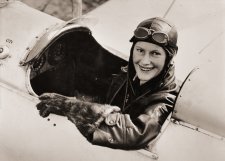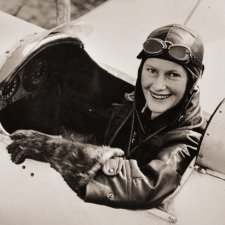I’d first flown in 1930 and had made up my mind that I was going to learn to fly. And I had bought myself a helmet and goggles, because I had taken an instructional flight and nobody’s helmet was small enough for my head, so I had to have one made and then I studied books on aviation, away in the country, two hundred miles from any aeroplane. And when Kingsford Smith was coming to a town 13 miles away, on his barnstorming tour to the township of Wingham on the north coast of New South Wales, my sister and I decided that we would go in on the local cream truck and spend the day in Wingham and take a flight. That’s when I first met him and talked to him and told him I was going to learn to fly. And he said, ‘When you come to Sydney, come and see me, I’ll be starting my flying school’, and nobody was more surprised than Kingsford Smith when I turned up on his doorstep and became his first pupil at his flying school at Mascot.
After I finished my training, I then decided the only way to stay in aviation was to get hold of an aeroplane, no matter how much of a rattletrap it was, and get out into the country and barnstorm. The idea was to fly over a town and circle it for several times and then people would come out to see the aeroplane or to go for a flight. And of course shows and race meetings, they just hopped across the fence or they just came over, and those who wanted to fly – who were courageous enough to fly with these two young girls – would pay ten shillings for a flight in our little Gypsy Moth, it was a Gypsy One Moth, open cockpit aeroplane.
There were always those people, especially the young people and children that wanted to fly. There were always those smart alecs who wanted to send their friend up but wouldn’t go themselves, you know, and say, ‘Give him the works, do some aerobatics, you know, loop the loop and do some spins and turn it inside out’. And their great joy was to see their friend coming down looking green, but I don’t think we involved ourselves much in this.













